
In astronomy, a double planet is a binary satellite system where both objects are planets, or planetary-mass objects, that share an orbital axis external to both planetary bodies.

Pluto is a dwarf planet in the Kuiper belt, a ring of bodies beyond the orbit of Neptune. It is the ninth-largest and tenth-most-massive known object to directly orbit the Sun. It is the largest known trans-Neptunian object by volume, by a small margin, but is less massive than Eris. Like other Kuiper belt objects, Pluto is made primarily of ice and rock and is much smaller than the inner planets. Pluto has only one sixth the mass of Earth's moon, and one third its volume.

A natural satellite is, in the most common usage, an astronomical body that orbits a planet, dwarf planet, or small Solar System body. Natural satellites are colloquially referred to as moons, a derivation from the Moon of Earth.
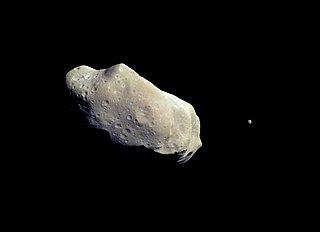
A minor-planet moon is an astronomical object that orbits a minor planet as its natural satellite. As of January 2022, there are 457 minor planets known or suspected to have moons. Discoveries of minor-planet moons are important because the determination of their orbits provides estimates on the mass and density of the primary, allowing insights into their physical properties that are generally not otherwise accessible.
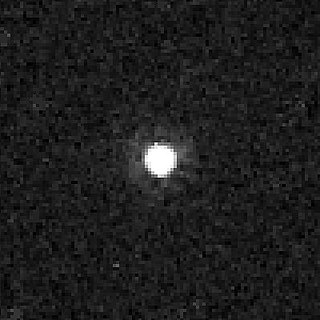
28978 Ixion (, provisional designation 2001 KX76) is a large trans-Neptunian object and a possible dwarf planet. It is located in the Kuiper belt, a region of icy objects orbiting beyond Neptune in the outer Solar System. Ixion is classified as a plutino, a dynamical class of objects in a 2:3 orbital resonance with Neptune. It was discovered in May 2001 by astronomers of the Deep Ecliptic Survey at the Cerro Tololo Inter-American Observatory, and was announced in July 2001. The object is named after the Greek mythological figure Ixion, who was a king of the Lapiths.
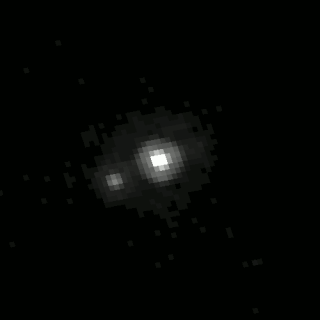
Orcus is a large trans-Neptunian object located in the Kuiper belt, with one large moon, Vanth. It has an estimated diameter of 870 to 960 km, comparable to the Inner Solar System dwarf planet Ceres. Orcus had been accepted by many astronomers as a dwarf planet, though as of 2024 that consensus has changed. The surface of Orcus is relatively bright with albedo reaching 23 percent, neutral in color, and rich in water ice. The ice is predominantly in crystalline form, which may be related to past cryovolcanic activity. Other compounds like methane or ammonia may also be present on its surface. Orcus was discovered by American astronomers Michael Brown, Chad Trujillo, and David Rabinowitz on 17 February 2004.
Chadwick A. Trujillo is an American astronomer, discoverer of minor planets and the co-discoverer of Eris, the most massive dwarf planet known in the Solar System.

Haumea is a dwarf planet located beyond Neptune's orbit. It was discovered in 2004 by a team headed by Mike Brown of Caltech at the Palomar Observatory in the United States and disputably also in 2005 by a team headed by José Luis Ortiz Moreno at the Sierra Nevada Observatory in Spain. On September 17, 2008, it was named after Haumea, the Hawaiian goddess of childbirth, under the expectation by the International Astronomical Union (IAU) that it would prove to be a dwarf planet. Nominal estimates make it the third-largest known trans-Neptunian object, after Eris and Pluto, and approximately the size of Uranus's moon Titania.

Makemake is a dwarf planet and the second-largest of what is known as the classical population of Kuiper belt objects, with a diameter approximately that of Saturn's moon Iapetus, or 60% that of Pluto. It has one known satellite. Its extremely low average temperature, about 40 K (−230 °C), means its surface is covered with methane, ethane, and possibly nitrogen ices. Makemake shows signs of geothermal activity and thus may be capable of supporting active geology and harboring an active subsurface ocean.

38628 Huya ( hoo-YAH; provisional designation 2000 EB173) is a binary trans-Neptunian object located in the Kuiper belt, a region of icy objects orbiting beyond Neptune in the outer Solar System. Huya is classified as a plutino, a dynamical class of trans-Neptunian objects with orbits in a 3:2 orbital resonance with Neptune. It was discovered by the Quasar Equatorial Survey Team and was identified by Venezuelan astronomer Ignacio Ferrín in March 2000. It is named after Juyá, the mythological rain god of the Wayuu people native to South America.
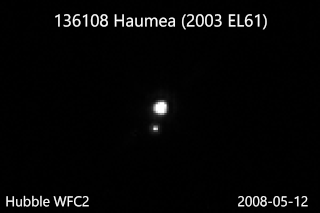
Hiʻiaka is the larger, outer moon of the trans-Neptunian dwarf planet Haumea. It is named after one of the daughters of Haumea, Hiʻiaka, the patron goddess of the Big Island of Hawaii. It orbits once every 49.12±0.03 d at a distance of 49880±198 km, with an eccentricity of 0.0513±0.0078 and an inclination of 126.356±0.064°. Assuming its estimated diameter of over 300 km is accurate, it may be the fourth- or fifth-largest known moon of a Trans-Neptunian object, after Pluto I Charon, Eris I Dysnomia, Orcus I Vanth, and possibly Varda I Ilmarë and Salacia I Actaea.

A dwarf planet is a small planetary-mass object that is in direct orbit around the Sun, massive enough to be gravitationally rounded, but insufficient to achieve orbital dominance like the eight classical planets of the Solar System. The prototypical dwarf planet is Pluto, which was regarded as a planet before the "dwarf" concept was adopted in 2006.

Eris is the most massive and second-largest known dwarf planet in the Solar System. It is a trans-Neptunian object (TNO) in the scattered disk and has a high-eccentricity orbit. Eris was discovered in January 2005 by a Palomar Observatory–based team led by Mike Brown and verified later that year. In September 2006, it was named after the Greco–Roman goddess of strife and discord. Eris is the ninth-most massive known object orbiting the Sun and the sixteenth-most massive overall in the Solar System. It is also the largest known object in the solar system that has not been visited by a spacecraft. Eris has been measured at 2,326 ± 12 kilometers (1,445 ± 7 mi) in diameter; its mass is 0.28% that of the Earth and 27% greater than that of Pluto, although Pluto is slightly larger by volume. Both Eris and Pluto have a surface area that is comparable to the area of Russia or South America.

The dwarf planet Haumea has two known moons, Hiʻiaka and Namaka, named after Hawaiian goddesses. These small moons were discovered in 2005, from observations of Haumea made at the large telescopes of the W. M. Keck Observatory in Hawaii.

Gonggong is a dwarf planet, a member of the scattered disc beyond Neptune. It has a highly eccentric and inclined orbit during which it ranges from 34–101 astronomical units from the Sun. As of 2019, its distance from the Sun is 88 AU, and it is the sixth-farthest known Solar System object. According to the Deep Ecliptic Survey, Gonggong is in a 3:10 orbital resonance with Neptune, in which it completes three orbits around the Sun for every ten orbits completed by Neptune. Gonggong was discovered in July 2007 by American astronomers Megan Schwamb, Michael Brown, and David Rabinowitz at the Palomar Observatory, and the discovery was announced in January 2009.
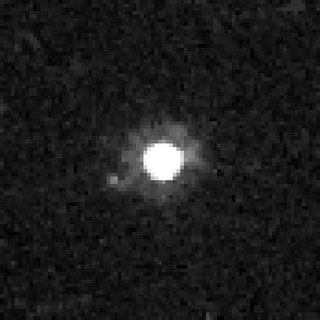
Quaoar is a ringed dwarf planet in the Kuiper belt, a region of icy planetesimals beyond Neptune. A non-resonant object (cubewano), it measures approximately 1,086 km (675 mi) in diameter, about the size of Saturn's moon Dione or half the size of Pluto. The object was discovered by American astronomers Chad Trujillo and Michael Brown at the Palomar Observatory on 4 June 2002. Signs of water ice on the surface of Quaoar have been found, which suggests that cryovolcanism may be occurring on Quaoar. A small amount of methane is present on its surface, which can only be retained by the largest Kuiper belt objects.
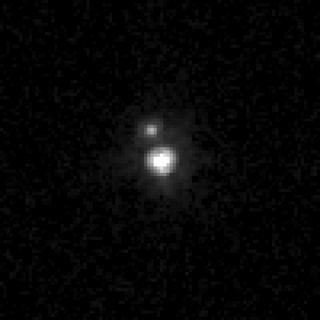
Vanth is a natural satellite or moon of the large trans-Neptunian object 90482 Orcus. It was discovered by Michael Brown and Terry-Ann Suer using images taken by the Hubble Space Telescope on 13 November 2005. The moon has a diameter of 443 km (275 mi), making it about half the size of Orcus and the third-largest moon of a trans-Neptunian object. Vanth is massive enough that it shifts the barycenter of the Orcus–Vanth system outside of Orcus, forming a binary system in which the two bodies revolve around the barycenter, much like the Pluto–Charon system. It is hypothesized that both systems formed similarly, most likely by a giant impact early in the Solar System's history. In contrast to Orcus, Vanth has a darker and slightly redder surface that apparently lacks exposed water ice, resembling primordial Kuiper belt objects.

A planetary-mass moon is a planetary-mass object that is also a natural satellite. They are large and ellipsoidal in shape. Moons may be in hydrostatic equilibrium due to tidal or radiogenic heating, in some cases forming a subsurface ocean. Two moons in the Solar System are larger than the planet Mercury : Ganymede and Titan, and seven are larger and more massive than the dwarf planets Pluto and Eris.






















